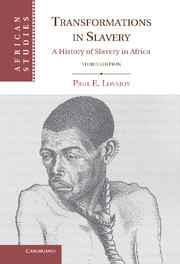Book contents
- Frontmatter
- Contents
- Maps and Tables
- Note on Currencies, Weights, and Measures
- Preface
- Preface to the Second Edition
- Preface to the Third Edition
- 1 Africa and Slavery
- 2 On the Frontiers of Islam, 1400–1600
- 3 The Export Trade in Slaves, 1600–1800
- 4 The Enslavement of Africans, 1600–1800
- 5 The Organization of Slave Marketing, 1600–1800
- 6 Relationships of Dependency, 1600–1800
- 7 The Nineteenth-Century Slave Trade
- 8 Slavery and “Legitimate Trade” on the West African Coast
- 9 Slavery in the Savanna during the Era of the Jihads
- 10 Slavery in Central, Southern, and Eastern Africa in the Nineteenth Century
- 11 The Abolitionist Impulse
- 12 Slavery in the Political Economy of Africa
- Epilogue
- Appendix Chronology of Measures against Slavery
- Notes
- Select Bibliography
- Index
- Books in this series
2 - On the Frontiers of Islam, 1400–1600
Published online by Cambridge University Press: 05 June 2012
- Frontmatter
- Contents
- Maps and Tables
- Note on Currencies, Weights, and Measures
- Preface
- Preface to the Second Edition
- Preface to the Third Edition
- 1 Africa and Slavery
- 2 On the Frontiers of Islam, 1400–1600
- 3 The Export Trade in Slaves, 1600–1800
- 4 The Enslavement of Africans, 1600–1800
- 5 The Organization of Slave Marketing, 1600–1800
- 6 Relationships of Dependency, 1600–1800
- 7 The Nineteenth-Century Slave Trade
- 8 Slavery and “Legitimate Trade” on the West African Coast
- 9 Slavery in the Savanna during the Era of the Jihads
- 10 Slavery in Central, Southern, and Eastern Africa in the Nineteenth Century
- 11 The Abolitionist Impulse
- 12 Slavery in the Political Economy of Africa
- Epilogue
- Appendix Chronology of Measures against Slavery
- Notes
- Select Bibliography
- Index
- Books in this series
Summary
Slavery was already fundamental to the social, political, and economic order of parts of the northern savanna, Ethiopia, and the East African coast for several centuries before 1600. Enslavement was an organized activity, sanctioned by law and custom. Slaves were a principal commodity in trade, including the export sector, and slaves were important in the domestic sphere, not only as concubines, servants, soldiers, and administrators but also as common laborers. The combination of enslavement, trade, and employment of slaves in the domestic economy indicates that a slave mode of production had developed, although the scarcity of source material limits an analysis of the transformation that resulted in this situation. From 1400 to 1600, the geographical area where slavery was most important included a strip of territory along the southern borders of the Sahara Desert, the Red Sea shores, and the East African coast. For the period as a whole, slavery tended to expand; the use of slaves followed trade routes further into the interior from this narrow strip of territory, and the source of slaves for export tended to be south of the desert edge and inland from the Red Sea.
The dominant influence was Islamic, both because the major external market for slaves was North Africa and the Middle East and because Islam had become a strong influence within many of the states and societies in the northern savanna, the Ethiopian highlands, and the East African coast where slaves were used extensively. The use of slaves in these places was similar to their use elsewhere in the Muslim world, although in sub-Saharan Africa slaves were more often used in production than they were in North Africa and the Middle East. A secondary influence in this period was the introduction of European commerce into the south Atlantic basin and the Indian Ocean. This contributed to the general expansion of slavery within Africa, in part because Europeans distributed slaves between different places on the African coast and in part because Europeans began to buy slaves on an increasingly large scale for their own use.
- Type
- Chapter
- Information
- Transformations in SlaveryA History of Slavery in Africa, pp. 24 - 44Publisher: Cambridge University PressPrint publication year: 2011

